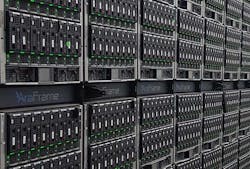Colocation and Hosting Providers Push Enterprise Data Center Ops. Forward
In this week’s Voices of the Industry column, Dan Draper, Director of Data Center Programs for Vertiv, shares the story of how colocation and hosting providers have pushed traditional enterprise data center operations into the future.
Dan Draper, Director of Data Center Programs for Vertiv
It doesn’t matter if you’re a colocation provider or manager of an enterprise data center, your challenges are still the same; do what you do, but do it faster, cheaper and better. Since Colocation or Multi-Tenant Data Centers (MTDC) are in a competitive arena vying for business, they want to be the fastest, cheapest and best, and thus many are much further ahead in achieving these goals. But fastest, cheapest and best is also being pursued by almost every Enterprise data center in existence.
So what can Enterprise facilities (and a few of you Colos too!) learn from how MTDCs build and operate their facilities and apply it elsewhere? First let’s examine the mindset of MTDCs and dig deeper into their goals and how the meet their owners’ needs and their customers’ needs.
[clickToTweet tweet=”It doesn’t matter if you’re a colocation provider or manager of a data center, your challenges are still the same.” quote=”It doesn’t matter if you’re a colocation provider or manager of an enterprise data center, your challenges are still the same.”]
Based on some soon-to-be-published research from Vertiv (you get an early sneak peak here), I’ll group all the various tasks and objectives of MTDCs into three goals:
- Increase Revenue
- Reduce Costs
- Manage Risk
Increase Revenue
Ok, the first goal, Increase Revenue, is the least applicable to Enterprise data center managers, but we shouldn’t skip it entirely. From my basic marketing courses in college (Go Buckeyes), I know MTDCs have two levers they can pull to increase revenue; price and promotion. Lowering price will attract customers but MTDCs also need to maintain profitability, so having an extremely energy efficient operation is going to give that facility more wiggle room in pricing. High efficiency thermal management using economization, regardless if it’s water-side or air-side, helps MTDCs be competitive in price. For Enterprise facilities, that benefit goes straight to the bottom line. Sure, I could have put energy efficiency into Reduce Costs, but having a state of the art facility also helps MTDCs and Enterprise sites with the second P – promotion. By utilizing the latest technologies in power and thermal, Enterprise facilities can lower costs and also promote themselves inside their organization or in their community.
By utilizing the latest technologies in power and thermal, Enterprise facilities can lower costs and also promote themselves inside their organization or in their community.
Good corporate stewardship doesn’t directly impact revenue but the data center is a big target and our Enterprise facilities should be doing their part for the company.
Reducing Costs
While I covered the easy stuff about Reducing Costs through energy efficiency, let’s look at another dimension of cost and talk about managing expansions and growth. The days of building an entire facility then slowly populating it with IT is fortunately long gone. MTDCs have mastered the art of tying their costs to their revenue. Meaning, in many cases the power and cooling infrastructure doesn’t get deployed until the customer signs the contract. Enterprise customers can utilize this just-in-time approach through modular design. If you’re building new, the entire facility could be modular, or if we just need additional power capacity, skids and containers are ideal. Modularity can also be pushed down into the aisle. Racks, rack PDUs and power busways can all be deployed quickly and purchased when you need them.
Manage Risk
For our last goal, Manage Risk, Enterprise data center operations managers have clearly been doing it longer. But MTDCs have multiple businesses depending on them, so they have become better at managing the two biggest causes of downtime: battery failure and human error. MTDCs rigorously test, monitor and service their entire power chain, especially their UPS batteries. MTDCs manage risk and the human error component by making sure their facility is compliant with the latest codes and standards and also by limiting human interaction in the equipment yard or white space to just trained service technicians.
Roughly 49% of data center managers (more of that research preview I brought up earlier) have some type of compute located off premise in a Colo or hosting environment. Clearly we’re all partners in this very unique field and we’re fortunate to be able to share what we do to keep the vital applications of the world up and running (and doing it faster, cheaper and better of course!).
Dan Draper is Director of Data Center Programs for Vertiv (formally Emerson Network Power). Draper and his team are currently focused on identifying emerging industry trends and how they drive new data center infrastructure technology and design innovations.


